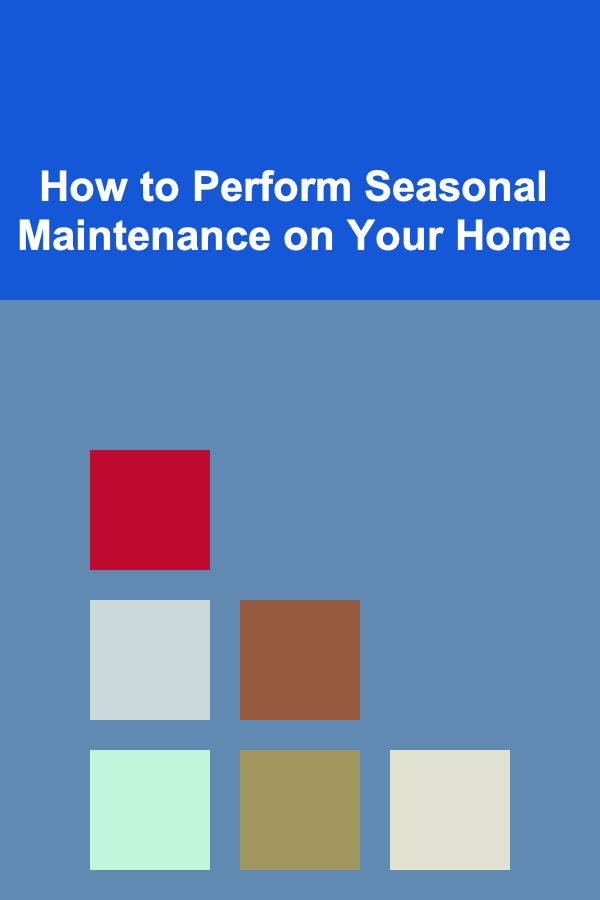
How to Prepare Your HVAC System for Winterization
ebook include PDF & Audio bundle (Micro Guide)
$12.99$8.99
Limited Time Offer! Order within the next:
Not available at this time

As the colder months approach, it's crucial to prepare your HVAC system for winter to ensure it continues to run efficiently and effectively throughout the season. Failing to properly winterize your HVAC system can lead to costly repairs, energy inefficiency, or even a complete system breakdown during the dead of winter. In this comprehensive guide, we'll walk you through the steps necessary to winterize your HVAC system and ensure it runs smoothly when you need it the most.
Why Winterizing Your HVAC System is Important
The colder weather can place a significant strain on your HVAC system. When winter sets in, heating systems, especially furnaces and heat pumps, are called into action more frequently. To avoid unexpected breakdowns, costly repairs, or inefficient heating, it's essential to winterize your system.
Some of the key benefits of winterizing your HVAC system include:
- Preventing breakdowns: Cold weather can exacerbate issues with your HVAC system. Winterizing your system helps identify and address potential problems before they result in a costly breakdown.
- Ensuring energy efficiency: A well-maintained HVAC system works more efficiently, saving you money on heating bills.
- Extending the life of your system: Regular maintenance and preparation can prevent unnecessary wear and tear on the system, prolonging its lifespan.
Now, let's walk through the essential steps to ensure your HVAC system is ready for the winter season.
1. Change the Air Filter
The air filter is one of the most important components of your HVAC system, and it's often overlooked. Air filters trap dust, dirt, and other debris to ensure clean air circulates throughout your home. Over time, these filters can become clogged, restricting airflow and making your HVAC system work harder than necessary.
Why is it important to change the air filter?
- A clogged filter reduces the efficiency of your system and can lead to overheating or breakdowns.
- It improves indoor air quality by preventing allergens from circulating.
- Changing the air filter helps your system run more smoothly, reducing energy costs.
How to change the air filter:
- Turn off the HVAC system to avoid any accidents.
- Locate the air filter -- typically, it's found near the air handler or furnace.
- Remove the filter and check for damage or dirt buildup.
- If the filter is clogged or damaged, replace it with a new one. Make sure it matches the size specifications of your system.
- Install the new filter in the same direction as the old one, usually indicated by an arrow on the frame.
Tip: Depending on usage, it's recommended to change the air filter every 1-3 months during the winter season.
2. Clean the Furnace or Heater
Your furnace or heating unit is the heart of your HVAC system during winter. Keeping it clean ensures it operates efficiently, reducing the risk of breakdowns.
Steps to clean your furnace or heater:
- Turn off the power: Always turn off the power to the furnace before cleaning to ensure safety.
- Inspect the area around the furnace: Clear away any debris, dust, or clutter around the furnace. Keeping the area around your furnace clean allows it to breathe and operate efficiently.
- Clean the blower: Use a vacuum or a brush to remove dust and dirt from the blower fan and motor.
- Check the burner: If you have a gas furnace, inspect the burner for any dirt or blockages. You may need a professional for a deeper cleaning of the burner and heat exchanger.
Professional Inspection: While basic cleaning is something you can do yourself, it's highly recommended to schedule an annual professional furnace inspection. A technician can perform a thorough cleaning, check for leaks, and ensure that everything is in good working order before the cold weather hits.
3. Check and Calibrate the Thermostat
Your thermostat controls the temperature in your home by regulating the HVAC system's heating or cooling output. Over time, thermostats can become inaccurate, resulting in inefficient energy use or even uncomfortable indoor temperatures.
Why calibrate the thermostat?
- Ensure accurate readings: A thermostat that's out of calibration can result in your system running more than necessary, leading to energy waste.
- Optimize system performance: Proper calibration ensures your HVAC system runs only when needed, improving overall efficiency.
Steps to check and calibrate the thermostat:
- Check for accuracy: Place a separate thermometer in the same room as your thermostat and compare the readings. If there is a significant difference (more than 2°F), your thermostat may need recalibration.
- Reset the thermostat: If your thermostat is digital, you may need to reset it to factory settings or recalibrate it via the settings menu. Check the manufacturer's guide for instructions.
- Replace the batteries: If you have a battery-operated thermostat, replace the batteries to ensure it operates properly during the winter months.
If your thermostat is old or malfunctioning, consider upgrading to a smart thermostat. These devices learn your preferences and adjust the temperature for optimal comfort and energy savings.
4. Inspect the Ductwork
Leaky or damaged ducts can lead to heat loss and inefficient heating, especially in the colder months. Ensuring your ducts are sealed and insulated properly will help maintain consistent temperatures and reduce your heating costs.
Steps to inspect the ductwork:
- Visually inspect the ducts for any visible damage, such as holes or disconnected joints.
- Check for air leaks: Hold a lit incense stick near the ducts while the HVAC system is running. If the smoke is blown away, there's likely a leak.
- Seal any leaks: Use duct tape or, for a more permanent solution, mastic sealant to seal any gaps or leaks in the ducts.
- Insulate exposed ducts: If your ducts are in unheated spaces, such as an attic or basement, insulate them to prevent heat loss.
Sealing and insulating your ducts can significantly improve energy efficiency, saving you money on heating bills.
5. Inspect and Clean the Vents
Vents can accumulate dust, dirt, and debris, obstructing airflow and reducing system efficiency. It's important to clean the vents regularly to ensure air flows freely throughout your home.
How to clean vents:
- Turn off the HVAC system to prevent air from blowing debris around.
- Remove the vent covers: Use a screwdriver to take the vent covers off the walls or floor.
- Clean the vent covers: Wash the covers with soap and warm water to remove any dust or grime.
- Vacuum the vents: Use a vacuum with a hose attachment to clean out the dust inside the vent ducts.
- Reinstall the covers once they are clean.
Regular vent cleaning not only helps maintain system efficiency but also contributes to better indoor air quality.
6. Check the Outdoor Unit (For Heat Pumps)
If you have a heat pump system, the outdoor unit is crucial for heat exchange. While most HVAC systems have their outdoor components protected from the elements, it's still important to check and maintain the heat pump unit to prevent winter-related damage.
Steps to prepare the outdoor unit:
- Clear debris: Remove any leaves, twigs, or dirt that may have accumulated around the outdoor unit.
- Inspect for damage: Check the unit for any signs of wear, such as cracked or loose parts.
- Cover the unit: If you live in an area with heavy snow or ice, consider covering the outdoor unit with a weatherproof cover to prevent damage from freezing temperatures.
- Check the defrost mode: Ensure the unit is in proper defrost mode, as heat pumps can accumulate frost in winter, which may reduce efficiency.
7. Schedule a Professional Tune-up
Even if you perform all the above steps, it's always a good idea to have a professional HVAC technician inspect your system before winter. A technician can perform a thorough inspection, identify any potential issues, and make necessary repairs before the cold weather sets in.
What a professional tune-up includes:
- Checking refrigerant levels and recharging if necessary.
- Cleaning and lubricating moving parts, such as the blower and motor.
- Inspecting electrical components for wear and tear.
- Testing the system's overall performance and efficiency.
Conclusion
Properly preparing your HVAC system for winterization is essential to ensure that your home stays warm and comfortable all season long. From changing the air filter to scheduling a professional inspection, these steps will help your system run efficiently and avoid unnecessary breakdowns. Regular maintenance and proactive winterization can also extend the lifespan of your HVAC system, saving you money on costly repairs and replacements down the line. By taking the time to prepare your HVAC system for winter, you'll have peace of mind knowing you're ready for the cold weather ahead.

How to Create an Efficient Cleaning Schedule for Your Apartment
Read More
How to Organize Your Craft Supplies for Easy Access
Read More
How to Perform Seasonal Maintenance on Your Home
Read More
Marketing Analyst's Handbook: Techniques for Optimizing Campaign Performance and ROI
Read More
How to Build a Powerful LinkedIn Profile
Read More
How to Conquer Your Monthly Finances: A To-Do List for Success
Read MoreOther Products

How to Create an Efficient Cleaning Schedule for Your Apartment
Read More
How to Organize Your Craft Supplies for Easy Access
Read More
How to Perform Seasonal Maintenance on Your Home
Read More
Marketing Analyst's Handbook: Techniques for Optimizing Campaign Performance and ROI
Read More
How to Build a Powerful LinkedIn Profile
Read More